Crypto staking has massively grown as one of the innovative ways to earn passive income in the digital asset space. It also provides investors with an option to validate blockchain transactions alongside traditional mining while earning rewards on stake. Like any other investment strategy, however, staking comes with its pros and cons. In this article, we are going to discuss whether staking crypto is good or bad.
What is Crypto Staking?
Crypto-staking refers to a process or act of locking a certain amount of cryptocurrency in a blockchain network through some sort of consensus, basically Proof of Stake or the like. It is by staking your crypto that you get to take part in transaction validation on that network. You get some kind of reward in return, which is usually distributed periodically.
The Benefits of Staking Crypto
Staking has a number of potential advantages that lend themselves to making it quite attractive to the many crypto investors out there, including:
Earn Passive Income: Perhaps one of the largest benefits associated with staking is, of course, the ability to earn passive income. You stand to earn regular rewards for staking.
Network Security: With staking, it contributes to the security of the blockchain network through transaction validation. The process forms an integral part of maintaining network integrity and stability, which leads to benefits accruing to all participants in the network.
Low Entry Barriers: Most staking platforms, like those on OkayCoin, have normally lower minimums required for entrance and thus are more inclusive of even small-time investors who could also receive returns.
Variety of staking options: OkayCoin has different staking platforms with changing rewards and risk profiles. They have different investment strategies.
Daily Rewards: Depending on the many platforms, it pays rewards daily and, if reinvested, will compound returns over time.
Risks of Staking Crypto
While staking has some advantages, there is also the possibility to consider some potential risks as mentioned below.
Market volatility: Your cryptocurrency will fluctuate in value by large margins. If the value of your staked assets falls, your reward earned may or may not cover the fall in value.
Lock-up periods: Some of the staking systems will require one to lock up his assets for a certain period. Within that time, it would not be possible even to trade his or her staked crypto, and that might be a drawback if market conditions change.
Network Risks: The security and stability of the blockchain network you stake on are important. Your staked assets could be in jeopardy when there are certain problems in the network, such as a security breach or a hard fork.
Staking Plans on OkayCoin
OkayCoin offers several different staking systems, catering to the large variety of investors in the cryptocurrency space. Some of the most popular options include the following:
Ethereum: As one of the largest Proof of Stake networks currently in operation, Ethereum can provide relatively good rewards when considering staking. ETH staked with OkayCoin contributes to security for the transition into Ethereum 2.0.
Polygon: it is a very fast network with low transaction fees. Hence, staking on OkayCoin is a go-to choice for many investors looking to gain daily rewards from MATIC.
Tron: one such unique staking opportunity that has been focused on decentralized content creation. A stake of TRX on the blockchain using the service provided by OkayCoin contributes to the growth of this network while you earn regular rewards from it.
Polkadot: This is a multi-chain by Polkadot that offers very high staking rewards.
Celestia: This is one of the newer options to stake through OkayCoin and focuses on solving blockchains scaling.
Aptos: designs scalability and ease of use. APT staking on OkayCoin rewards daily but also contributes to the security and efficiency of network operations.
Sui: Sui provides high-performance blockchain surroundings, especially in DeFi. Staking SUI through OkayCoin, users may earn rewards while contributing to the network's growth.
Avalanche: Avalanche is renowned for fast and inexpensive transactions. OkayCoin could let AVAX staking yield rewards and contribute to network stability in return.
Cardano: Scientific work on the Cardano blockchain makes this project popular for staking. Staking ADA on OkayCoin yields stable rewards as a contribution to further network projects.
Solana: This is indeed a very promising staking candidate, given that it features high throughput and low fees.
How to Sign Up for Staking on OkayCoin
Getting started with staking on the OkayCoin exchange is pretty easy to do:
Sign-up: Go to the website of OkayCoin and create an account on the exchange using your e-mail address. Complete the verification steps necessary to secure your account.
Deposit Crypto: Transfer the crypto assets that need to be staked into the OkayCoin wallet. Supported assets include Ethereum, Polygon, Cardano, and many more.
Choose a Staking Pool: Browse through all the stakings available on OkayCoin and choose the pool most suitable for your investment goals. To be specific, most of the information needed for decision-making involves the rate of staking yield, lock-up period, and daily reward amount.
Start Staking: Your crypto gets locked in the selected staking pool. You can track your rewards via the OkayCoin dashboard; you might want to reinvest them to compound your rewards.
Referral Program
Finally, don't let the referral program of OkayCoin pass you by. You will invite friends to join the platform and stake on it. You get additional rewards, which means boosting returns even higher.
Conclusion
Staking crypto is one of the most rewarding passive income strategies among all, especially for those who support blockchain networks. By being aware of how staking works, making a careful selection of the staking pool you are in, and basically taking full advantage of OkayCoin's intuitive interface, you'd be assured of maximum rewards with the least risks. Finally, staking may turn to be good or bad, considering some investment goals and levels of market risk one would be willing to bear.
Disclaimer: This is a sponsored article and is for informational purposes only. It does not reflect the views of Crypto Daily, nor is it intended to be used as legal, tax, investment, or financial advice.





